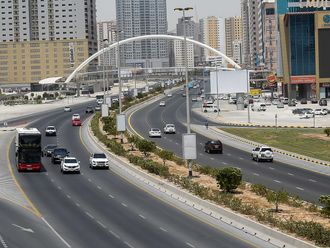Dubai: The Heavy Vehicles Defects Clearing System (VDCS), which was recently launched by the Roads and Transport Authority (RTA) in cooperation with Dubai Police, will reduce accidents significantly, RTA has announced.
As heavy vehicles are responsible for 20 per cent of accidents in Dubai, the system, which is being jointly implemented and monitored, was reviewed by top officials from both sides to improve its efficiency in detecting defects and ensuring prompt repair.
Mattar Al Tayer, Chairman of the Board and Executive Director of RTA, met Major General Khamis Mattar Al Mazeina, Dubai Police Chief, and the two parties discussed the implementation of the Heavy Vehicles Defects Clearing System (VDCS) which is aimed at enhancing road traffic safety.
The system, which involves the introduction of surveillance systems and smart technologies, is intended to curb technical defects experienced by heavy vehicles, minimise traffic accidents triggered by heavy vehicles and classify the risks of vehicles and operators through adopting a mechanism for calculating the probability of a vehicle/operator’s failure to comply with the standards set by the RTA.
“The VDCS is an integrated system of effective policies and smart technological applications that enables the RTA and the Dubai Police as well as the operators of heavy trucks to examine and analyse data pertaining to vehicle faults using vehicles’ and drivers’ risks and safety systems at world-class standards,” said Al Tayer.
He added that the RTA has carried out a comprehensive study in coordination with a specialist consultancy firm about the traffic safety of heavy vehicles using the ‘Maturity Model’ of heavy vehicle safety and benchmarked it against the practices of advanced countries.
“We have also constructed vehicles’ safety database, developed a vehicles’ and drivers’ risks assessment system, and conducted a random testing of equipment and remote tracking systems for various models and brands, ages and makes of heavy vehicles,” said Al Tayer.
Talking about the system Major General Al Mazeina said: “Through the system, operators and owners of companies can identify attitudes of offending drivers, the operational condition of the truck, and the availability of the required safety stipulations such as the brakes, engine and tyres and, accordingly, take appropriate steps and decisions necessary for eliminating the occurrence of accidents or technical faults.”
Explaining the system, Ahmad Hashem Behroozian, CEO of RTA’s Licensing Agency, said that the system contributes to identifying vehicles not in compliance with the traffic policies and rules, and accordingly helps stop offending vehicles on roads to calculate the risk rating by using inputs from the on-road technical testing, remote detection of faults and the annual technical inspection.
“Whenever a vehicle is inspected and no faults detected, it will be treated as compliant with the safety standards and awarded a rating of zero in every inspection where no faults are detected. Each inspection of the vehicle will be considered a single inspection and a point will be assigned in respect of each fault or offence, based on the gravity of the detected faults. All points will be listed and a final rating out of ten will be assigned in addition to a colour-coded classification,” said Behroozian.
He added: “Upon the implementation of the system, the RTA will migrate from the conventional control and inspection of heavy vehicles to smart monitoring through using data storage and analysis system, automation of inspection process by using sophisticated tablets for inspecting heavy vehicles, assessing and classifying risks of vehicle faults, setting guidelines and controls on vehicles and operators against whom major offences are reported, and issuing smart reports for assisting the analysis of factors underlying recurrence of offences and accidents.”












